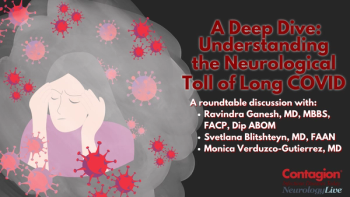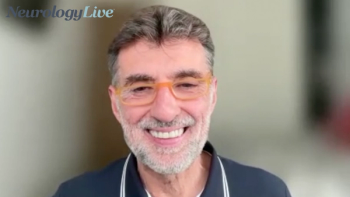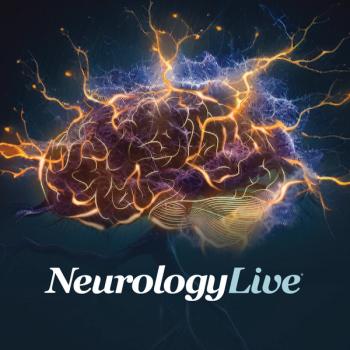
A new study presented at AANEM 2024 revealed that daily dosing of oral edaravone was well tolerated and did not reveal any new safety concerns in patients with amyotrophic lateral sclerosis.

Isabella Ciccone, Associate Editor, NeurologyLive®, has been with the team since September 2022. Follow her on Twitter @iciccone7 or email her at [email protected]

A new study presented at AANEM 2024 revealed that daily dosing of oral edaravone was well tolerated and did not reveal any new safety concerns in patients with amyotrophic lateral sclerosis.

In our latest roundtable series, experts discussed Long COVID prevalence, underreporting, accurate diagnosis, and emphasized that Long COVID serves as an umbrella term.

The director of the Helen and Robert Appel Alzheimer’s Disease Research Institute at Weill Cornell Medicine talked about findings from a recently published study on immune responses to Alzheimer disease risk genes between male and female mice. [WATCH TIME: 4 minutes]

Sarah Anderson, PharmD, NBC-HWC, senior director of clinical resources and programming at National MS Society, talked about the significant updates under the Inflation Reduction Act to come in 2025 for patients with multiple sclerosis.

The senior director of clinical resources and programming at National MS Society discussed the significant updates to Medicare Part D in 2025 that will cap annual out-of-pocket costs and introduce a flexible payment plan option for enrollees. [WATCH TIME: 9 minutes]

Catch up on any of the neurology news headlines you may have missed over the course of September 2024, compiled all into one place by the NeurologyLive® team.

The postdoctoral research assistant at Charité University Berlin discussed how the new diagnostic criteria for multiple sclerosis could offer earlier detection, especially in those with overlapping autoimmune conditions, through advanced imaging markers.

The hope is that NP001 could potentially slow the progression of the disease through its unique immunologic mechanism.

The chair of neurology at Hospital Universitari Vall d’Hebron talked about the revision of the MS diagnostic criteria that will integrate new evidence, biological markers, and advanced MRI findings to enable earlier and more precise diagnoses. [WATCH TIME: 4 minutes]

The orphan medicinal product designation given by the European Commission was based on findings produced in research funded by the United States Department of Defense.

The assistant professor at the University of Naples discussed how implementation of new diagnostic criteria for multiple sclerosis will involve practical adjustments in imaging and diagnostic techniques as well as cultural changes in clinical practice. [WATCH TIME: 4 minutes]

Ongoing analysis of vamorolone's effects as a mineralocorticoid receptor antagonist in healthy adults is underway, with results to be presented at upcoming medical conferences.

The neurologist at the University Hospital Center of Nice discussed whether radiologically isolated syndrome represents a pre-symptomatic phase of multiple sclerosis based on a hot topic session held at the 2024 ECTRIMS Congress. [WATCH TIME: 4 minutes]

A duo of experts talked about a positive phase 2 trial of vidofludimus calcium, demonstrating reductions in serum neurofilament light levels and potentially slowing brain atrophy in patients with progressive multiple sclerosis. [WATCH TIME: 4 minutes]

A recent survey showed that patients with Parkinson disease quickly adapted to using continuous subcutaneous apomorphine infusion therapy, with high amount of recommending the device to others.

Amantadine extended-release capsules, approved for levodopa-related dyskinesia and OFF episodes in Parkinson disease, offer high amantadine concentrations that peak in the time of first morning levodopa dose.

As part of our monthly clinician spotlight, NeurologyLive® highlighted neuromuscular-associated cardiomyopathy expert Forum Kamdar, MD, PhD, FACC, FHFSA, an advanced heart failure physician-scientist at the University of Minnesota.

Path to Prevention is a platform, phase 2 trial that will investigate the safety and efficacy of investigational interventions in patients neuronal α-synuclein disease stage 2B.

Findings from a new study presented at MDS 2024 suggest that variations in cholinergic denervation patterns may hold promise for differentiating Parkinson disease and progressive supranuclear palsy with parkinsonism.

The consultant neurologist at Queen's Square MS Center in London gave his clinical viewpoint on the newest revision of the McDonald criteria for diagnosing patients with multiple sclerosis. [WATCH TIME: 3 minutes]

The chief research officer of the Muscular Dystrophy Association talked about what is to be expected at the 2025 MDA Conference, held March 16-19, in Dallas, Texas. [WATCH TIME: 5 minutes]

The approval follows phase 3 data that showed significant improvements in neurological symptoms and functional benefit over 12 weeks in patients with Niemann-Pick disease type C.

Zevra Therapeutics plans to immediately start its launch activities for arimoclomol, marketed as Miplyffa, which is anticipated to be commercially available in 8 to 12 weeks in the United States.

The postdoctoral researcher at Amsterdam University Medical Center talked about the DAAE score 2.0 which offers an improved, validated clinical tool to predict the risk of transitioning to secondary progressive multiple sclerosis. [WATCH TIME: 5 minutes]

The consultant neurologist at Queen's Square MS Center in London discussed the shift in the updates to the McDonald criteria for multiple sclerosis presented at ECTRIMS 2024.

The phase 1b/2a dose escalation trial of KINE-101, conducted in Korea, includes patients with chronic inflammatory demyelinating polyneuropathy who have received at least 1 frontline treatment regimen.

In honor of Restless Legs Syndrome Awareness Day, held September 23, 2024, the American Academy of Sleep Medicine spokesperson talked about the condition and its impact on the United States population as well as the criteria to diagnose it. [WATCH TIME: 3 minutes]

A new study presented at ECTRIMS 2024 revealed that 80% of patients with relapsing multiple sclerosis had an estimated no evidence of disease activity rate at both 3 and 4 years when discontinuing cladribine tablets.

Results showed that the immune response observed in patients with multiple sclerosis was specifically modified by treatments interfering with Epstein-Barr virus hosts cells or activated lymphocytes.

In a phase 3 study, tolebrutinib demonstrated a statistically significant delay in time to onset of confirmed disability progression in patients living with non-relapsing secondary progressive multiple sclerosis.